7
Temporal Bone Imaging
Rebecca S. Cornelius
Imaging of temporal bone pathology relies primarily on computed tomography (CT) and magnetic resonance imaging (MRI).1,2 Other modalities, including angiography and nuclear medicine imaging, have a role limited to specific clinical situations.
Imaging procedures of choice in various clinical situations are discussed in the subsections of this chapter. In general, MRI offers advantages of multiplanar imaging capability without requiring the patient to lie in uncomfortable positions. MRI provides better detail of soft tissue abnormalities as well as more specific characteristics of mass lesions. However, imaging time is usually considerably longer than with CT and requires a higher level of patient cooperation to achieve high-quality images. Likewise, patients with claustrophobia usually experience greater difficulty with MRI than with CT. Newer-generation helical multislice CT technology now allows for rapid scan times and high-quality multiplanar reconstructions, often obviating the need for scanning directly in two planes. A high-detail temporal bone CT performed using these techniques requires less than 10 minutes of patient time in the CT scanner and actual scan time of under 30 seconds for a single plane study.
MRI is contraindicated in some patients with implanted metallic devices or foreign bodies: pacemakers, certain aneurysm clips, cardiac valves, cochlear and other metallic implants, and metallic foreign bodies in the globe or orbit. MRI centers keep extensive lists of implanted devices that are known to be MRI compatible or incompatible. Radiologists and technologists operating MRI scanners should be able to determine whether a particular device implanted in a patient can be exposed to the magnetic field without risk.
The cost of CT examination is usually 20% to 40% less than MRI; however, in most instances of temporal bone evaluation, one test is clearly the procedure of choice over the other as far as diagnostic value. Thus, the issue of cost differential does not realistically come into play in most situations.
As a general guideline for choosing imaging modalities, readers are referred to the introductory chapter of Imaging of the Temporal Bone by Swartz and Harnsberger.3 This covers in detail an algorithmic approach to imaging based on the patient’s clinical presentation.
 Imaging of Diseases of the External Auditory Canal
Imaging of Diseases of the External Auditory Canal
Disease processes that affect the external auditory canal (EAC) include congenital dysplasias (Fig. 7–1), benign and malignant neoplasms, and inflammatory disease. These entities are covered in detail in Chapters 16 and 26.
Imaging of EAC disease is best accomplished with CT scanning to ensure that the cortex of the osseous portion of the EAC is fully evaluated.3,4
In patients with aggressive malignant neoplasms additional evaluation with MRI with gadolinium contrast enhancement may be warranted if there is evidence of intracranial extension. Extension into adjacent extracranial tissue such as the parotid space usually can be evaluated with either contrastenhanced CT or MRI.
Likewise, patients with necrotizing external otitis (NEO) with suspicion of intracranial spread may require additional imaging with MRI. Detection of meningeal involvement and complications such as abscess or sinus thrombosis will be better detected with MRI than CT.
Extracranial spread into the temporomandibular joint, parapharyngeal space, and masticator space usually is adequately evaluated with contrast-enhanced CT,5 but also is well evaluated with MRI. MRI also detects bony signal changes in osteomyelitis.6,7
Some studies advocate the use of radionuclide imaging in the diagnosis and follow-up of NEO. Both technetium-99m (Tc-99m) and gallium-67 citrate have been used.7–9 Tc-99m is a bone-scanning agent that demonstrates increased uptake in areas of increased osteoblastic activity. It is more sensitive than CT for early changes of osteomyelitis in the skull base,10 but does not delineate soft tissue changes, which are clearly seen with CT scanning. The bone scan will remain abnormal for months even if there is no active infection. Gallium-67 citrate scintigraphy is more specific for active infection, and serial scanning has been used to predict resolution of NEO.11 However, there are documented cases of patients with recurrent or persistent NEO who have had normal gallium scans.12
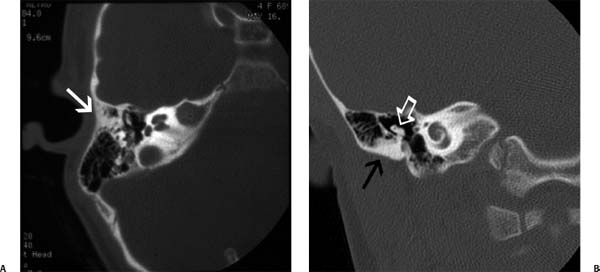
Figure 7–1 External auditory canal atresia. (A) Axial computed tomography (CT) image of external auditory canal (EAC) and middle ear shows absent EAC (solid arrow) as well as abnormal appearance of the ossicles. (B) Coronal CT image demonstrates absent EAC (solid arrow) as well as fusion of the ossicular mass to the lateral wall of the attic at the level of the atresia plate (open arrow). (Courtesy of Bernadette Koch, M.D.)
Indium-111 white blood cell scan in combination with Tc-99m single photon emission computed tomography (SPECT) scan has also been shown to be useful in the diagnosis and follow-up of skull base osteomyelitis in patients with NEO.13
 Imaging of Diseases of the Mastoid and Middle Ear
Imaging of Diseases of the Mastoid and Middle Ear
Diseases of the mastoid and middle ear cavity include congenital anomalies (Chapter 1), inflammatory disease (Chapters 17 and 19), and neoplasms (Chapters 24 and 26).
The initial imaging evaluation of mastoid and middle ear pathology relies primarily on high-resolution noncontrast CT14,15 (Figs. 7–2 and 7–3). MRI is extremely valuable in the assessment of patients with intracranial complications from otomastoiditis and cholesteatoma. Meningitis, subdural or epidural empyema, and intracranial abscess are much better demonstrated with MRI than CT. Sigmoid sinus thrombophlebitis is also better demonstrated on MRI. If findings of venous thrombosis are equivocal on routine spin-echo images, magnetic resonance venography can be utilized for confirmation. MRI is also superior in detecting encephaloceles, which may develop at sites of postsurgical or erosive defects in the tegmen.16
Paragangliomas including glomus tympanicum and jugulotympanicum involve the middle ear cavity. Their imaging evaluation is discussed later in this chapter.
 Imaging of Disease of the Inner Ear
Imaging of Disease of the Inner Ear
Congenital malformations of the inner ear are covered in Chapters 1 and 22. Other processes that may lead to imaging evaluations include inflammatory disease, otodystrophies, and neoplasms.
Imaging of patients with suspected otodystrophy relies heavily on high-resolution CT scanning.17–19 Otosclerosis is covered in detail in Chapter 20.20–22 Other otodystrophies including fibrous dysplasia and Paget’s disease demonstrate classic findings on CT.3 Extensive areas of bony demineralization are evident with the cotton-wool appearance seen in calvarial bone in Paget’s disease.23,24 Patients with fibrous dysplasia demonstrate areas of enlarged dense bone with a ground-glass appearance to the matrix. Although patients with Paget’s disease and those with fibrous dysplasia have visible abnormalities on MRI, the changes are frequently less diagnostic on MRI than on CT and do not warrant the added expense.
Imaging of patients with inner ear inflammatory disease is performed to exclude other causes of vertigo. Patients with acute labyrinthitis frequently show abnormal signal or enhancement within the membranous labyrinth on MRI. The findings are a nonspecific indication of inflammation.
Labyrinthitis ossificans can occur as a sequelae of labyrinthitis, most frequently following a bacterial infection. CT and MRI are both useful in the detection of labyrinthitis ossificans (Figs. 7–4 and 7–5).25,26 On MRI obliteration of the normal fluid signal within the membranous labyrinth on high-resolution T2-weighted sequences can be detected. In the early stages, MR findings may be more obvious than the CT findings of subtle labyrinthine sclerosis.27
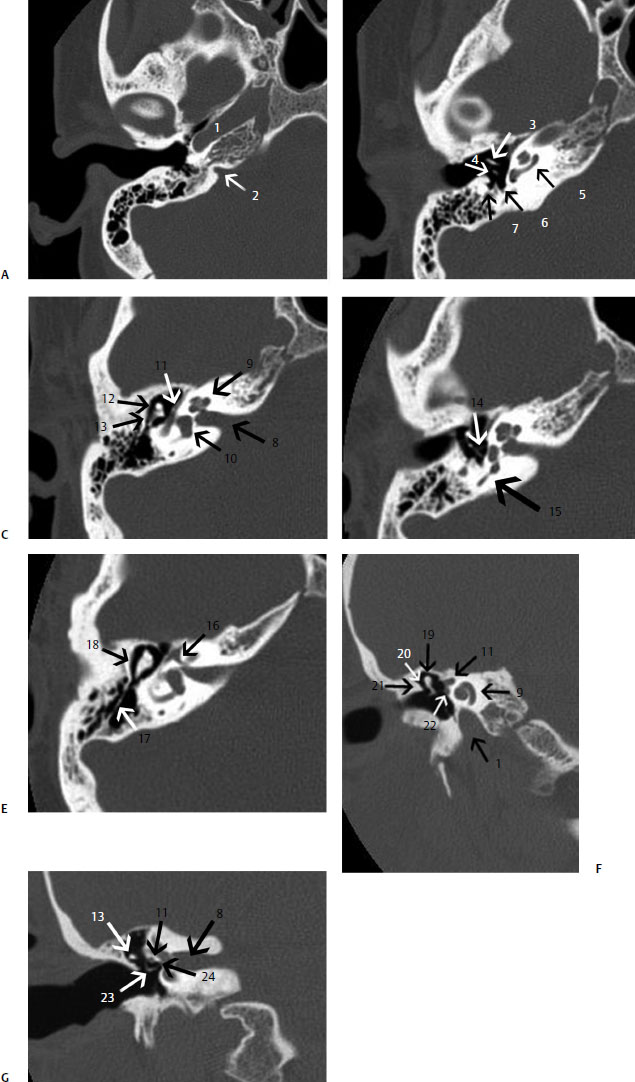
Figure 7–2 (A–E) Normal anatomy axial CT image. (F,G) Normal anatomy CT coronal image. 1, Carotid canal; 2, cochlear aqueduct; 3, malleus handle; 4, long process incus; 5, basal turn of cochlea; 6, sinus tympani; 7, facial recess; 8, internal auditory canal; 9, cochlea—2nd turn and apex; 10, vestibule; 11, tympanic segment facial nerve canal; 12, malleus head; 13, short process incus; 14, stapes crura; 15, posterior semicircular canal; 16, labyrinthine segment facial nerve canal; 17, Koerner’s septum; 18, incus body; 19, tegmen; 20, Prussak’s space; 21, scutum; 22, tensor tympani; 23, lenticular process of incus; 24, oval window.
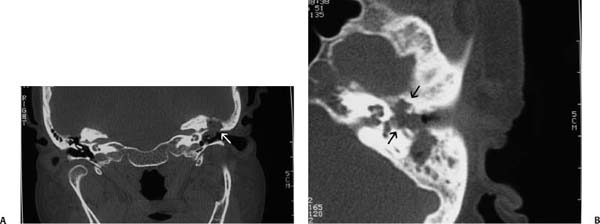
Figure 7–3 Cholesteatoma. (A) Coronal CT image shows soft tissue mass filling the attic with erosion of the ossicles and blunting of the scutum (arrow). (B) Axial CT image shows large soft tissue mass and absent ossicles as well as erosion of the medial and lateral walls of the attic (arrows).
Rare intralabyrinthine schwannomas are easily detected on gadolinium-enhanced MRI.28
With improved visualization of inner ear structures using 3D and high-resolution techniques, MRI is playing an increasing role in the detection and diagnosis of inner ear pathology.29–45
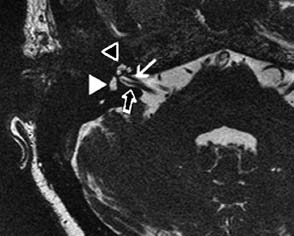
Figure 7–4 Normal anatomy axial three-dimensional Fourier transform-constructive interference in steady state (3DFT-CISS) magnetic resonance imaging (MRI). There is excellent visualization of the cochlear division (solid arrow) and vestibular division (open arrow) of cranial nerve VIII. Fluid signal intensity is seen within the vestibule (solid arrowhead) and cochlea (open arrowhead). Close examination of the cochlea demonstrates the modiolus and spiral lamina are visible as low signal intensity areas within the high signal fluid spaces of the cochlea.
 Imaging of Diseases of the Skull Base, Internal Auditory Canal, and Cerebellopontine Angle
Imaging of Diseases of the Skull Base, Internal Auditory Canal, and Cerebellopontine Angle
The main categories of disease to be considered include neoplasms and cysts, inflammatory disease, and vascular lesions including normal vascular variants. Imaging of the skull base, internal auditory canal (IAC), and cerebellopontine angle (CPA) has been greatly improved since the advent of MRI.46–49 This is the one area of temporal bone imaging where MRI clearly supplants CT as the initial imaging test of choice in most instances. MRI also plays a role in the evaluation of patients with pulsatile tinnitus. MRI/magnetic resonance angiography (MRA) can detect petrous carotid aneurysm, glomus tumor, atherosclerotic carotid stenosis, advanced fibromuscular dysplasia (FMD), and high-flow dural arteriovenous malformation/ fistula.50,51 However, many patients with objective pulsatile tinnitus require conventional angiography for more complete evaluation of lesions detected on MRI or for treatment purposes (Fig. 7–6). Low-flow dural fistulas may not be detected with MRI/MRA. Likewise, subtle FMD may be mistaken as an artifactual finding on MRA. Thus, it may be more cost-effective to proceed directly to conventional angiography in patients with objective pulsatile tinnitus. In patients with subjective pulsatile tinnitus, imaging to exclude several normal vascular variants is necessary. These are all well demonstrated with CT imaging.51 Uncommonly subjective tinnitus may be related to kinking or stenosis in the high cervical internal carotid artery, or to venous sinus stenosis. MRA and MR venography can be of use in detecting such abnormalities. Pulsatile tinnitus is covered in more detail in Chapter 35.
MRI allows for excellent delineation of tumors and cysts of the skull base, IAC, and CPA.52–54 Schwannomas of the fifth, seventh, and eighth cranial nerves typically demonstrate intermediate signal on T1-weighted images (T1WI), and high signal on T2-weighted images (T2WI).55 They enhance intensely with gadolinium (Figs. 7–7 and 7–8). Even small intracanalicular acoustic schwannomas are easily detected with MRI with gadolinium and with high-resolution 3D technique (Fig. 7–9).56–58
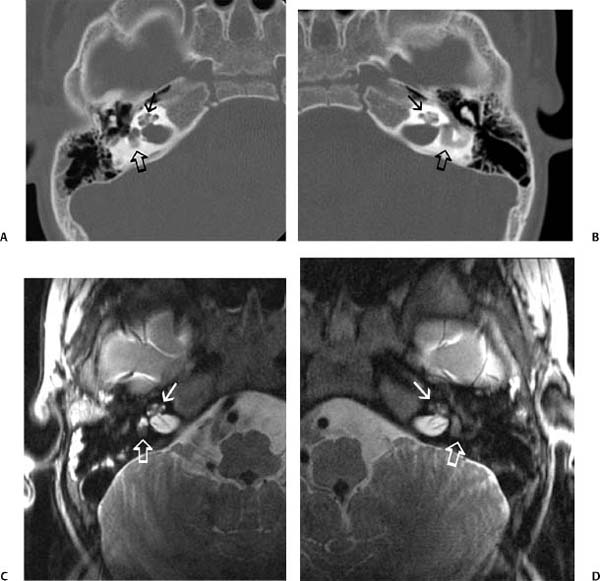
Figure 7–5 Labyrinthitis ossificans in a 3-year-old boy with a history of meningitis. (A,B) Axial CT images show subtle abnormal hazy sclerosis in the cochlea (solid arrows), vestibule, and semicircular canals (open arrows). (C,D) Axial high-resolution T2-weighted MRI demonstrates areas of obliteration of normal fluid signal within the cochlea (solid arrows), vestibule, and semicircular canals (open arrows). Compare with the normal appearance in Fig. 7–4. (Courtesy of Richard Wiggins, M.D.)
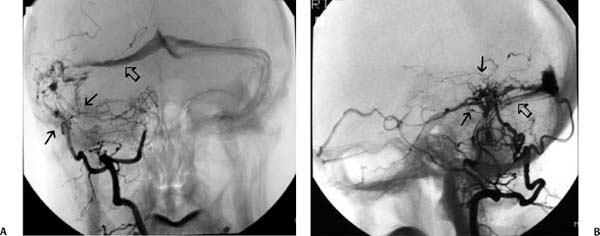
Figure 7–6 Dural fistula in a patient with pulsatile tinnitus. Vertebral angiogram anteroposterior (AP) (A) and lateral (B)
Stay updated, free articles. Join our Telegram channel

Full access? Get Clinical Tree


